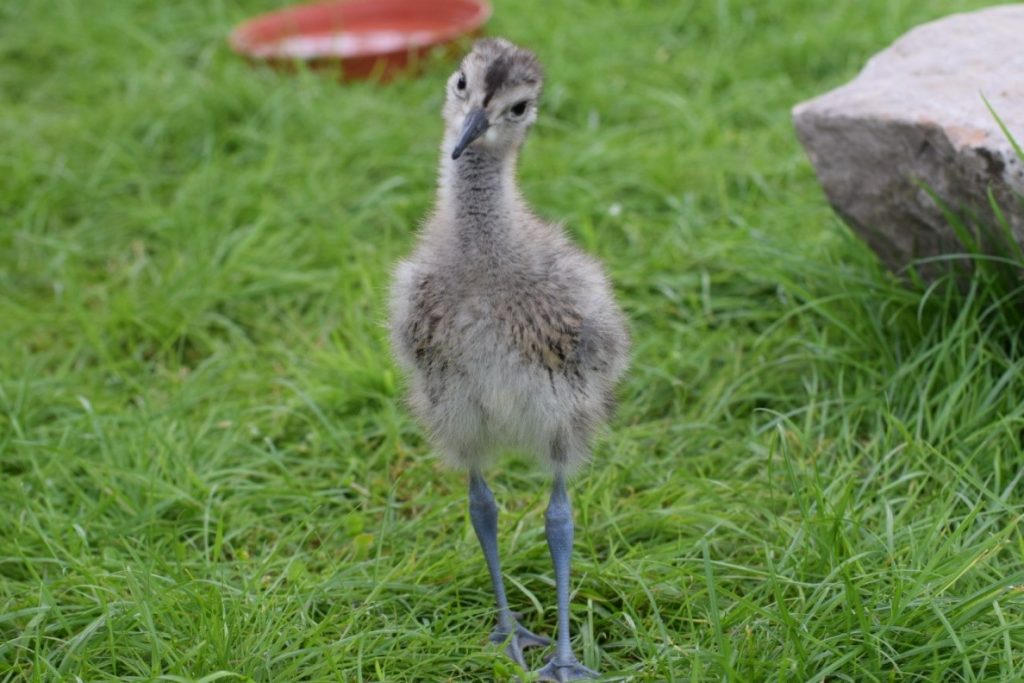The morning arrived and we were up at the stables for 8.30am, ready to get stuck into our cleaning and feeding duties. A quick look into each tank showed everybody accounted for, Tiny sitting down amongst the others of his brood, not unusual on occasion so I proceeded to move some of the other broods into their clean tanks. Back to Tiny’s brood, still sitting, now I start to get concerned. I reach in – usually an act that sparks outrage and quick fleeing to the furthest corner to escape my evil grasp. He makes efforts to move but it becomes clear that something is wrong. He cannot stand.
I feel disbelief. This chick that we have worked so hard to help survive, who was making progress, looking so good the night before, now cannot walk. All I could think was anyone but Tiny – he had already been through so much! We try to feel his legs, they can still move, and he still places pressure on my hand when I hold him, nothing appears broken. We take a video to send to our vets for advice and move him to a brooder on his own where we can monitor him closely.
After consultations with and research from different sources, we have a long list of possible deficiencies and causes. Another recently hatched chick had been deficient in Thiamine (B1) which was quickly resolved by an injection of the missing vitamin. Perhaps this was the cause of Tiny’s issue too? We whisked him off to the vet at lunch time to get his vitamin dose and hoped it might help. Hours passed but no obvious change. Following our vet’s advice we started him on a second course of antibiotics and began doing sling therapy with him to try and keep the blood flowing through his legs.
The next day came and still he was not walking. He could move around his brooder in a strange hobbling fashion, remaining able to reach food and water. We continued dosing him with antibiotics, and even took him to the vets for an x-ray to check his bone density – which after inspection by an expert seemed fine for his age. We continued over the next few days to watch him closely, putting him in his sling for 10-minute intervals and encouraging him to move his legs. Unfortunately, he took a turn for the worse and started to dramatically splay his legs to the sides.

Splayed legs are sometimes seen in young chicks and can usually be prevented by covering their brooder in non-slip matting to help them grip more easily. This we did with Tiny’s brooder, covering any of his flat surfaces but still the splaying continued to worsen. He began to stand in an odd fashion, on his tiptoes with his beak on the floor like a tripod, legs out wide. We were not sure how long we could continue with him but decided to try a few more days since he was still eating and seemed very active otherwise.
We made him a splint from tape to stop his legs from splaying too far out, keeping them in a better position under his body. In addition, our vets suggested he might be deficient in Riboflavin (vitamin B2) saying that if it was not present in the food, we could try giving him a very small dose of Marmite! One other theory had been a vitamin D deficiency, which could have been exacerbated by his longer period inside (despite the presence of UV bulbs). All this culminated in us giving him marmite laced antibiotics in the morning before taking him outside for short periods and splinting his legs in between.

We gradually started to notice some improvements, one foot we realised was now flat on the ground rather than claw like. He began to stand more upright. We took a closer look at the still clawed foot, and felt it perhaps had less flexibility than the one that now was flat. We took the decision to give him a small dose of anti-inflammatory pain relief, along with a bit of marmite for good measure. On the 22nd of June, he was taken outside in the morning to stay in his small enclosure whilst feeding and watering of the elder birds was underway. He still had one club foot, but was moving around with more confidence and searching the grass for food.
I had left the afternoon feed to trainees Jake and Rebecca, having to run errands locally myself. On my return I got a phone call from Jake – could I come to the pens to take a look at Tiny. My brain started going through all the possible bad things that could have happened and the courses of action we might have to take. I rushed up to the pens, past Tiny’s empty little enclosure – oh no. What happened to him? My fear must have been apparent as Jake quickly gestured me over to the youngest group of Curlews. “Which one is Tiny?” he asked.

I looked, but all the chicks were walking about, probing, foraging and happy. Then I spotted one amongst them with no ring – Tiny. It could not be! I was astounded that over the past 7 hours somehow Tiny was now walking around without a care, as if nothing had been wrong. I spent a good 15 minutes just watching him in disbelief, before we decided to leave him to enjoy his re-found feet.
Tiny Tim is now nearing 5 weeks old and whilst still smaller than others his age, he is blending in well with his group mates. We may never know exactly which aspect of his care made the defining difference, we are all exceptionally grateful that we persevered.
Tiny Tim would almost certainly not have survived in the wild. Thanks to the efforts of our fantastic team and volunteers he as a chance of not just surviving but thriving.

